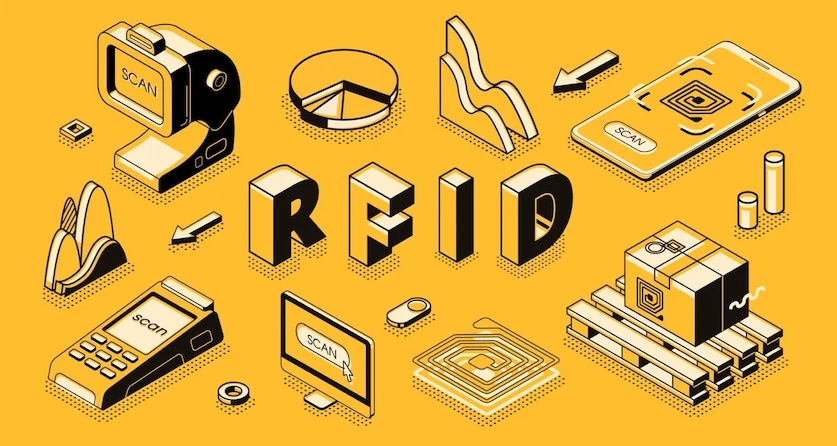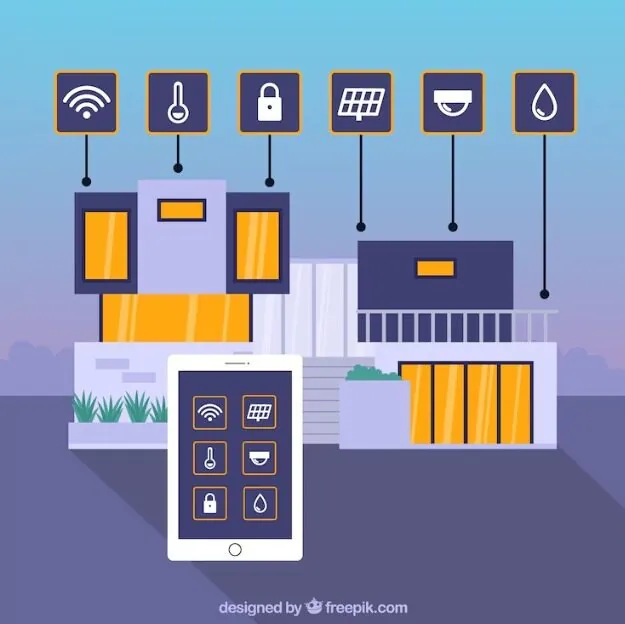How Is RFID Used for Time Tracking?
Radio-frequency identification, also known as RFID, is a technology that allows us to identify and track objects using radio waves. It’s like a special type of barcode that can be scanned without actually seeing it.
RFID works by using small tags, also known as smart labels, that are attached to objects or products. These tags contain a tiny chip and an antenna that communicates with a special reader using radio waves.
When the reader is nearby, it sends out a signal that powers the chip in the tag, allowing it to send back information to the reader. This information can include details about the object, such as its location or expiration date.

Image by vectorpouch on Freepik
What Are the Uses of RFID?
RFID technology is used in many ways today, here are a few examples:
- Inventory management: RFID technology is commonly used in warehouses and retail stores to track inventory. RFID tags can be attached to products, and scanners can quickly and accurately read the tags to monitor stock levels and reduce errors in inventory management.
- Asset tracking: It can be used to track valuable assets such as laptops, tools, and equipment. RFID tags can be attached to these items, and their location can be monitored in real-time, allowing for better asset management and theft prevention.
- Access control: RFID technology can be used for secure access control in a variety of settings, including office buildings, hospitals, and government facilities. RFID cards or tags can be used to grant access to authorised personnel and restrict access to unauthorised individuals.
- Livestock tracking: RFID tags can be used to track and monitor livestock, allowing farmers to keep track of their animals and monitor their health and well-being. This technology is especially useful for large-scale livestock operations.
- Passport and identity documents: Many passports and identity documents now use RFID technology to store and transmit personal information securely. This can help speed up the immigration and border control process and reduce the risk of identity fraud.
- Toll collection: RFID technology is often used for electronic toll collection on highways and bridges. Vehicles can have an RFID tag attached to the windshield, and tolls are automatically deducted from the driver’s account as they pass through the toll booth.
- Medical equipment tracking: It is also often used in hospitals and other medical facilities to track equipment, supplies, and medications. RFID tags can be attached to these items, and their location and usage can be monitored in real-time, reducing the risk of errors and improving patient safety.

Image by Freepik
Overall, RFID technology is a powerful tool that helps us keep track of items, reduce waste, and improve efficiency in many different industries.
Did you know that RFID is a popular choice for many employers when it comes to tracking the time their employees work? So how exactly can RFID be used for time tracking?
How RFID Is Used for Time Tracking
This wireless technology uses radio waves to exchange data between two devices: a reader and a tag. The reader sends out radio waves, and the tag, which is a small electronic chip with an antenna, receives the signal and sends back a response. This technology can operate over a range of several metres depending on the frequency and power used.
In the context of time tracking, employers can provide their employees with RFID badges that contain a chip with their name and employee ID number. The workplace will have an RFID reader installed, and when employees wave their badges in front of the reader, the chip on the badge will receive the radio waves and respond with their information. This information is then transmitted to a computer system that stores the data, providing an accurate and reliable record of the employees’ work hours.
Benefits of RFID Time Tracking
The benefits of RFID time tracking are numerous, including the elimination of manual time tracking errors and increased accuracy and efficiency in managing employee schedules. It also enables employers to monitor attendance, control access to restricted areas, and streamline payroll processing, saving time and reducing administrative costs.
Here are further reasons why businesses use RFID for time tracking:
- No more forgotten time cards or lost badges: Employees can easily and automatically clock in and out just by walking past a reader. It’s quick, it’s easy, and it ensures that everyone’s time is accurately recorded.
- Say goodbye to buddy punching: With RFID, employees can’t clock in or out for their friends. Each employee’s badge is unique, so only they can clock in or out using their own badge. This means no more time theft and no more conflicts with coworkers.
- Keep track of employee locations in real-time: Employers can see where their employees are in the workplace at any given time. This can be especially useful for large facilities, where it can be hard to keep track of everyone. Plus, it can help with safety and security measures.
- Better insights and analysis: Employers can collect data on employee attendance, productivity, and more. This data can be used to identify trends, spot problem areas, and make informed decisions about scheduling and staffing.
- No more manual data entry: RFID does the hard work, leaving employers with more time to focus on important things in the business.
- Easy integration with other systems: RFID time tracking systems can be integrated with other business software, such as payroll and HR systems, making it easier to manage employee data and processes.
- Customizable reporting: RFID time tracking systems can generate detailed reports on employee attendance, punctuality, and other metrics, which can be customised to meet specific business needs.
- Compliance with labour laws: Many countries have laws and regulations related to tracking employee work hours and breaks. RFID time tracking can help businesses comply with these laws and avoid legal issues.
How Does RFID Compare to NFC?
When it comes to time tracking, both RFID and NFC have their advantages and limitations. RFID has a longer read range, which makes it more suitable for tracking employees or assets in a large area, such as a warehouse or construction site. RFID tags can be read through materials like cardboard and plastic, which can be useful in certain work environments.
On the other hand, NFC has a shorter read range, making it more suitable for applications where direct contact or close proximity is needed, like tapping a card on a reader to clock in and out of work. NFC is also more compatible with mobile devices, making it a popular choice for applications like contactless payments and public transportation ticketing.
Ultimately, the choice between RFID and NFC for time tracking will depend on the specific needs and constraints of the workplace. One can certainly be caught in a time warp trying to decide whether to use the flashy NFC or the reliable RFID for time tracking. It’s important to weigh the pros and cons and choose the one that suits your business best.

